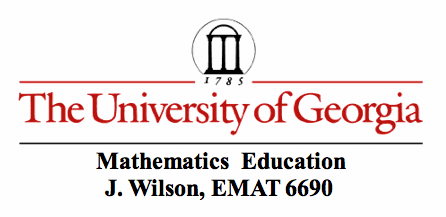

Most people you know multiply numbers by the arrangement of digits and carrying of numbers such as in the figure below for multiplying 23 and 51:
The Chinese interestingly used a different method in which sticks were used to represent the digits of each number and then the intersections of those sticks were counted in a specific way in order to get the correct product. Let's look at one example below.
Example 1:
In this example, we are multiplying 4 x 3. The four pink lines represent 4 and the three green lines represent 3. In order to get the product, we just count the number of orange intersections that the four pink lines and three green lines create. Thus, we get a product of 12.
But how does this work with numbers which have a tens, hundreds, or thousandths, digit? Let's try some more.
Example 2:
For this example, we now have two numbers who have both a tens digit and a ones digit. We should know that when multiplying these numbers we should get a three digit number (a number with a hundreds, tens, and ones digit). Therefore, we have to look at these intersections in a different way so that we will get a 3 digit number. The sticks are also organized in order to represent the two digits of each number. Thus, 16 has one green stick and then a group of six green sticks. The one green stick represent the tens digit and the six green sticks represent the ones digit. Similarly for 24 we have two purple sticks representing the tens digit and then a group of four purple sticks representing the ones digit.
The intersections of the ones digits or the group of six green sticks and four purple sticks within the blue circle will give us the ones digit of our product. However, we have 24 intersections. So, just like how we multiply we will need to carry the 2 over to our tens digit which we find in the pink circle from the intersections from the two cases of a ones digit with a tens digit. Here we find that there are 16 intersections in the pink circle, but we have to carry two from the ones digit so we have a total of 18. Then just like before, we need to carry our 1 over to our hundreds digit. We get our hundreds digit from the intersection of the tens digit with the tens digit. So, we find that there are two intersections within the orange circle. Yet, we have carried over a 1 from the previous tens digit so we have a total of 3 for hundreds digit. Thus, our final product is 384.
Okay now let's try an even more difficult one where both numbers have 3 digits.
Example 3:
In example 3, we are multiplying 123 and 213. We know that the intersection of the ones digits within the green oval will provide us with our total for the ones digit. Here we get a total of 9. We then need to find the tens digit of our product. This total comes from the orange oval where the ones digit (3) of 123 intersects with the tens digit (1) of 213 and the ones digit (3) of 213 intersects with the tens digit (2) of 123. So our total for the tens digit is also 9. Now we can look for our hundreds digit which is the intersections of a hundreds digit with a ones digit and also a tens digit with a tens digit. These intersections are found within our blue oval and we get a total of 11. This means that we need to carry one over to the thousandths digit. The thousandths digit can be found by the intersection of the tens digits with the hundreds digits within the yellow oval. Here we get a total of 5, yet we carried over 1 from the previous digit so our total becomes 6. Lastly, we have to have our ten-thousandths digit which is the intersection of the two hundreds digits or the 1 from 123 and the 2 from 213. So within the red oval we get a total of 2. Thus, our product of 123 and 213 is 26,199.
Teachers can use this multiplication with their students in a couple of different ways. First of all, it helps students to think more about what the multiplication of certain digits is providing to the product. Such as the multiplication of a ones digit and another ones digit will provide the ones digit of the product. While, the tens digits multiplied to the ones digits will provide the tens digit of the product. This type of stick method makes the students think about what digit is being multiplied rather than just following the algorithm to which they have become accustomed. This type of thinking could also be explained using partial product multiplication (see example below).
Here we take 425 x 3. We can think of 425 as 400 + 20 + 5 which shows that each digit sums to the total 425. Thus, (400 + 20 + 5) x 3 = 400(3) + 20(3) + 5 (3) = 1200 + 60 + 15 = 1275.

A second way that teachers could use this method of multiplication in their classrooms would be to use hands on materials such as pick up sticks or straws (image above) in order to allow the students who learn visually to place the 'sticks' however they may need. Other teachers could use Geometer's Sketchpad with preassigned problems such as in this file.
Overall, the Chinese Stick Multiplication ensures that the person who is performing the multiplication understands the base 10 system and the effect that each digit has during the multiplication.
Return